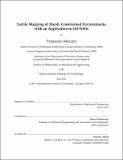Tactile mapping of harsh, constrained environments, with an application to oil wells
Author(s)
Mazzini, Francesco, Ph. D. Massachusetts Institute of Technology
DownloadFull printable version (4.990Mb)
Other Contributors
Massachusetts Institute of Technology. Dept. of Mechanical Engineering.
Advisor
Steven Dubowsky.
Terms of use
Metadata
Show full item recordAbstract
This work develops a practical approach to explore rough environments when time is critical. The harsh environmental conditions prevent the use of range, force/torque or tactile sensors. A representative case is the mapping of oil wells. In these conditions, tactile exploration is appealing. In this work, the environment is mapped tactilely, by a manipulator whose only sensors are joint encoders. The robot autonomously explores the environment collecting few, sparse tactile data and monitoring its free movements. These data are used to create a model of the surface in real time and to choose the robot's movements to reduce the mapping time. First, the approach is described and its feasibility demonstrated. Real-time impedance control allows a robust robot movement and the detection of the surface using a manipulator mounting only position sensors. A representation based on geometric primitives describes the surface using the few, sparse data available. The robustness of the method is tested against surface roughness and different surrounding fluids. Joint backlash strongly affect the robot's precision, and it is inevitable because of the thermal expansion in the joints. Here, a new strategy is developed to compensate for backlash positioning errors, by simultaneously identifying the surface and the backlash values. Second, an exploration strategy to map a constraining environment with a manipulator is developed. To maximize the use of the acquired data, this work proposes a hybrid approach involving both workspace and configuration space. The amount of knowledge of the environment is evaluated with an approach based on information theory, and the robot's movements are chosen to maximize the expected increase of such knowledge. Since the robot only possesses position sensors, the location along the robot where contact with the surface occurs cannot be determined with certainty. Thus a new approach is developed, that evaluates the probability of contact with specific parts of the robot and classifies and uses the data according to the different types of contact. This work is validated with simulations and experiments with a prototype manipulator specifically designed for this application.
Description
Thesis (Ph. D.)--Massachusetts Institute of Technology, Dept. of Mechanical Engineering, 2011. Cataloged from PDF version of thesis. Includes bibliographical references (p. [110]-114).
Date issued
2011Department
Massachusetts Institute of Technology. Department of Mechanical EngineeringPublisher
Massachusetts Institute of Technology
Keywords
Mechanical Engineering.